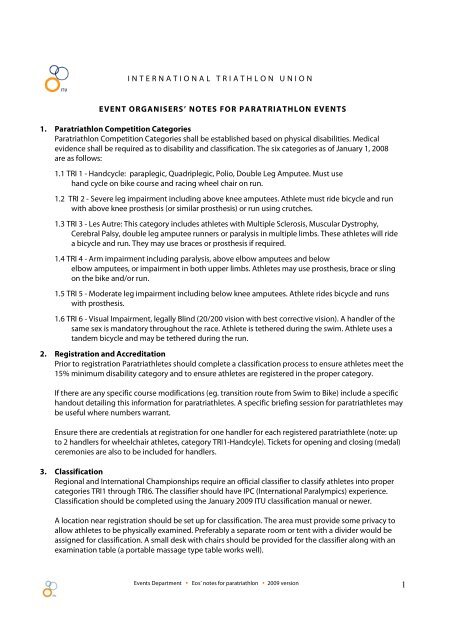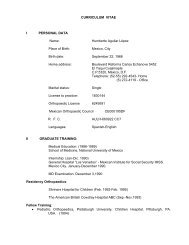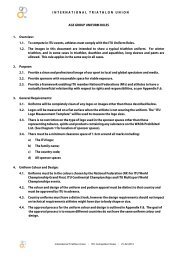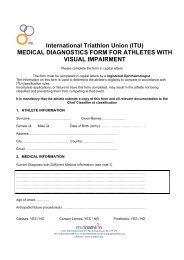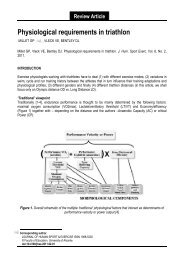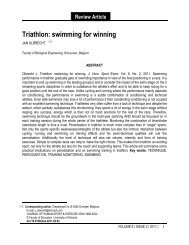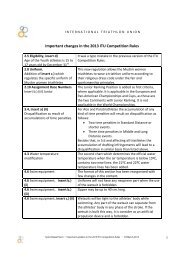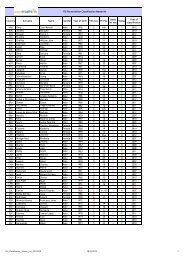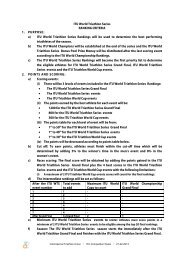EVENT ORGANISERS' NOTES FOR PARATRIATHLON EVENTS 1 ...
EVENT ORGANISERS' NOTES FOR PARATRIATHLON EVENTS 1 ...
EVENT ORGANISERS' NOTES FOR PARATRIATHLON EVENTS 1 ...
Create successful ePaper yourself
Turn your PDF publications into a flip-book with our unique Google optimized e-Paper software.
I N T E R N A T I O N A L T R I A T H L O N U N I O N<br />
EVEN T ORGANISERS’ <strong>NOTES</strong> <strong>FOR</strong> PA RATRIATHLON <strong>EVENT</strong>S<br />
1. Paratriathlon Competition Categories<br />
Paratriathlon Competition Categories shall be established based on physical disabilities. Medical<br />
evidence shall be required as to disability and classification. The six categories as of January 1, 2008<br />
are as follows:<br />
1.1 TRI 1 - Handcycle: paraplegic, Quadriplegic, Polio, Double Leg Amputee. Must use<br />
hand cycle on bike course and racing wheel chair on run.<br />
1.2 TRI 2 - Severe leg impairment including above knee amputees. Athlete must ride bicycle and run<br />
with above knee prosthesis (or similar prosthesis) or run using crutches.<br />
1.3 TRI 3 - Les Autre: This category includes athletes with Multiple Sclerosis, Muscular Dystrophy,<br />
Cerebral Palsy, double leg amputee runners or paralysis in multiple limbs. These athletes will ride<br />
a bicycle and run. They may use braces or prosthesis if required.<br />
1.4 TRI 4 - Arm impairment including paralysis, above elbow amputees and below<br />
elbow amputees, or impairment in both upper limbs. Athletes may use prosthesis, brace or sling<br />
on the bike and/or run.<br />
1.5 TRI 5 - Moderate leg impairment including below knee amputees. Athlete rides bicycle and runs<br />
with prosthesis.<br />
1.6 TRI 6 - Visual Impairment, legally Blind (20/200 vision with best corrective vision). A handler of the<br />
same sex is mandatory throughout the race. Athlete is tethered during the swim. Athlete uses a<br />
tandem bicycle and may be tethered during the run.<br />
2. Registration and Accreditation<br />
Prior to registration Paratriathletes should complete a classification process to ensure athletes meet the<br />
15% minimum disability category and to ensure athletes are registered in the proper category.<br />
If there are any specific course modifications (eg. transition route from Swim to Bike) include a specific<br />
handout detailing this information for paratriathletes. A specific briefing session for paratriathletes may<br />
be useful where numbers warrant.<br />
Ensure there are credentials at registration for one handler for each registered paratriathlete (note: up<br />
to 2 handlers for wheelchair athletes, category TRI1-Handcyle). Tickets for opening and closing (medal)<br />
ceremonies are also to be included for handlers.<br />
3. Classification<br />
Regional and International Championships require an official classifier to classify athletes into proper<br />
categories TRI1 through TRI6. The classifier should have IPC (International Paralympics) experience.<br />
Classification should be completed using the January 2009 ITU classification manual or newer.<br />
A location near registration should be set up for classification. The area must provide some privacy to<br />
allow athletes to be physically examined. Preferably a separate room or tent with a divider would be<br />
assigned for classification. A small desk with chairs should be provided for the classifier along with an<br />
examination table (a portable massage type table works well).<br />
Events Department Eos’ notes for paratriathlon 2009 version 1
The dates and times to be classified need to be posted in the athlete’s handbook and/or in the event<br />
schedule. The average time to classify an athlete is 15 minutes. Classification should be available on any<br />
day that has registration. Note that the classification process does not need to run for the full hours of<br />
registration.<br />
The classifier will be required to provide forms to complete the process. These forms should be<br />
submitted to the regional director for regional events and to the ITU for International events. The race<br />
director should provide the classifier with a database of paratriathletes registered in the event a<br />
minimum of one week prior to classification. This will allow the classifier to an opportunity to preclassify<br />
athletes that have been permanently classified at a previous triathlon event.<br />
4. Competition Rules<br />
LOCs should familiarize themselves with Section P of the ITU Competition Rules.<br />
5. Transition Area<br />
A distinct area within the transition area is required for paratriathletes. The required space per physically<br />
challenged athlete should be approximately two metres per athlete. This space will facilitate placement<br />
of both wheelchairs and handcycles for TRI1 athletes; as well this space will facilitate additional<br />
equipment required for categories TRI2 through TRI6. One chair is to be provided for each<br />
paratriathlete within their designated transition space. Chairs are to be provided for all paratriathlon<br />
categories.<br />
The transition area should be assigned to keep the distance from swim exit to transition no longer than<br />
necessary.<br />
6. Swim to Bike Transition<br />
Consideration needs to be given as to how athletes will move from the swim exit to the bike transition<br />
areas. Adaptation may be necessary to eliminate stairs or steep ramps not accessible by wheelchairs. In<br />
the case where a steep ramp is used to travel over a roadway; traffic may be required to stop for periods<br />
of time to allow paratriathletes the ability to get from the swim exit to the bike transition.<br />
A few additional volunteers may be needed to assist athletes at swim exit depending on the placement<br />
of wheelchairs, prosthesis and assistive devices. Several chairs may also be required at swim exit to<br />
assist athletes to don their prosthesis.<br />
7. Timing<br />
If a separate paratriathlon transition area is required to be moved outside of the general transition area,<br />
every consideration must be given to try to accommodate complete timing for Athletes with a Disability<br />
(eg. Swim, bike, run and transition splits).<br />
8. Course Considerations<br />
8.1 Swim<br />
Paratriathletes will start with a deep water start.<br />
In the case of a multiple loop swim, the entire swim portion of the event will be in the water. At no point<br />
other than the final exit from the swim will paratriathletes be required to exit the water (and then reenter<br />
the water).<br />
Wetsuits are permitted regardless of temperature using the athlete’s discretion.<br />
8.2 Bike<br />
Minimal accommodation is required for the bike course. Consideration may be required with extremely<br />
steep grades with respect to handcycles. In general age-group courses are appropriate. (For example<br />
Lausanne, Switzerland was challenging but fair)<br />
Events Department Eos’ notes for paratriathlon 2009 version 2
8.3 Run<br />
The run course must be fully wheelchair accessible. All steps must be eliminated. If there are any curbs<br />
on the run course, ramps are required to be placed over curbs to overcome the obstacle. Trail type run<br />
courses are not suitable. If a portion of the run course is a trail run an alternate run course for<br />
paratriathletes may be necessary.<br />
Ensure the run course is wide enough in all sections to allow a wheelchair athlete and another athlete<br />
space to pass each other.<br />
9. Approximate Course Times for Logistics<br />
Olympic Distance 1500m, 40km, 10km<br />
First<br />
Last<br />
First<br />
Last<br />
First<br />
Last<br />
Swimmer Swimmer Bike<br />
Bike<br />
Runner Runner<br />
20 min 45 min 1 h 30min 2h 30 min 2 h 15 min 4 h 0 min<br />
(Times are accumulative; therefore runner times are finish times)<br />
As a guideline, athletes should be able to complete an Olympic distance course in less than 4 hours.<br />
However given the course difficulty, weather conditions and the athlete; a course may need to be kept<br />
open longer than four hours.<br />
10. Medals<br />
There are six categories in each of the male and female divisions. This will result in the potential of 12<br />
Gold Medals, 12 Silver Medals and 12 Bronze Medals. Medals will be awarded up to third place in each<br />
category for each of male and female divisions. The ITU in conjunction with the LOC need to ensure<br />
enough medals are available for presentation ceremonies.<br />
If a stage is to be used for Medal ceremonies, ensure a ramp is provided for access by wheelchair<br />
athletes.<br />
Events Department Eos’ notes for paratriathlon 2009 version 3


